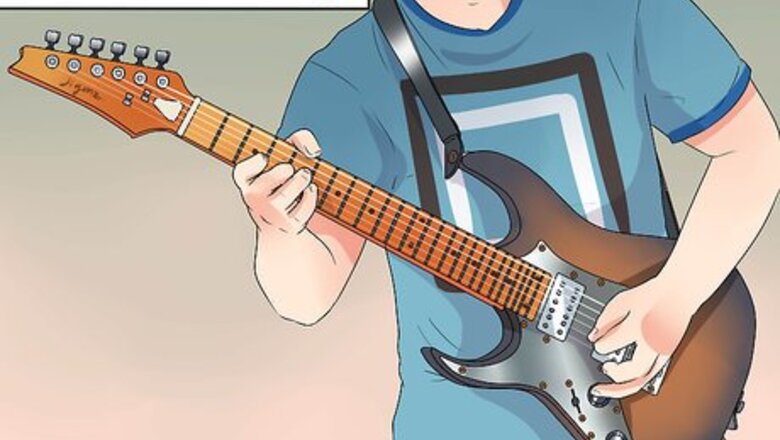
views
Practicing Effectively
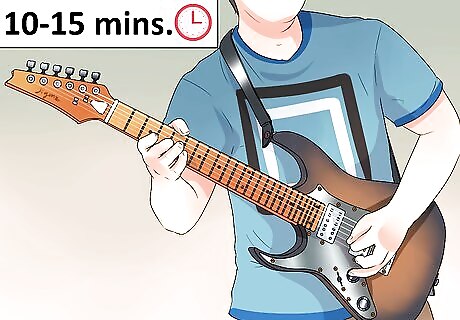
Start every practice session with 10-15 minutes of scales. Scales are an incredible way to warm up, and they are essential to becoming a good guitarist. You need to make scales a priority in your practice time, so put aside a set amount of time to practice them each day. Turn on a timer and work through every scale you know, playing them each on multiple sections of the guitar. Baseball players hit batting practice every day on a variety of pitches, artists doodle in a sketchbook, and writers free-write. Scales are the basic skill behind guitar theory and playing, and you need to devote time to practicing them.
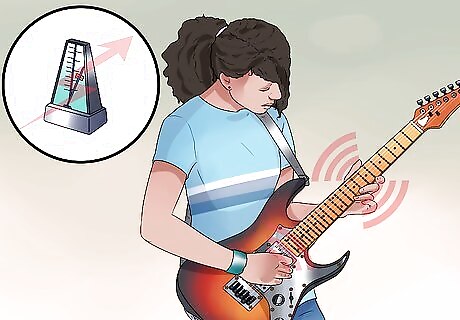
Practice with consistent rhythm and speed, avoiding mistakes. Do not rush through your scales, hitting 1-2 bum notes or missing a string here and there, just because you want to get faster. Speed means nothing if you're not hitting notes cleanly, so always practice with an ear for perfection. Once you've got the scales and exercises down at a certain tempo, then you can gradually increase your speed. It may be frustrating now, but it will make you a better guitarist in the long run. It is highly recommended that you play with a metronome for the best practice sessions.
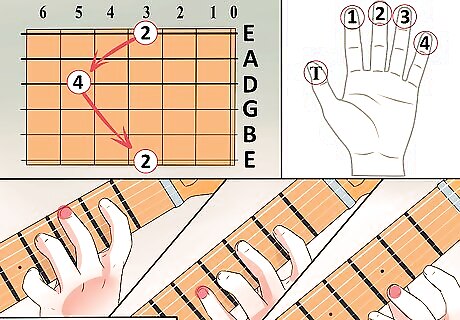
Skip strings as you play to build speed up and down the neck. Once you have the scales memorized up and down, it's time to kick your practice into the next level. Very rarely do you play a scale straight up and down, so you shouldn't always practice like that. Try the following string skipping exercises to master any scale. Play all the normal notes on your scale. Start with the 6th string (your thickest string), then skip to the 4th. Play the notes on the 4th string, then come back up to the 5th. Skip to the 3rd string, then come back to the 4th, moving up and down like this until you can hit them all in rhythm Skip from top to bottom, playing the 6th string, then the 1st. Then play the 5th string, followed by the 2nd, etc. After each string, return to the 6th string again so that you repeat the root note after every string. Once you've gone up and down like this, start repeating the 5th string, then the 4th, etc.
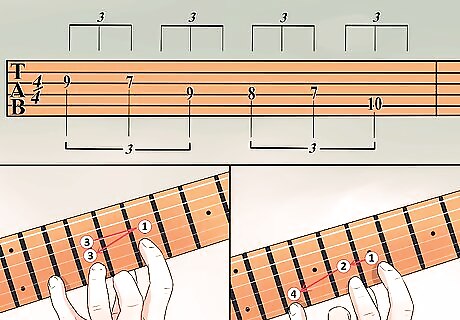
Play with triplets and quarter-note sets. This is a fantastic way to increase your speed both up and down the neck, and to add a bit of spice to your normal scale runs. Basically, you play the first note in a scale, then the next three in quick succession. You then return to the 2nd note in the scale and play the next three in quick succession. From there, you repeat the pattern all the way down, until you've done a set starting with every note in the scale. Try to string this together rhythmically -- not worrying about speed just yet. While you'd never play a full solo like this, you can adapt parts of this lick into your playing once you get better.
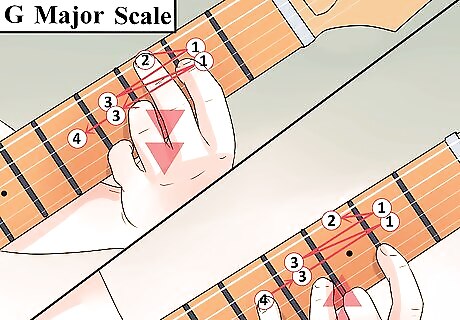
Try "down and backs" to learn to change direction quickly. This simple little exercise is a great way to comfortable speeding up and down the fretboard during solos. To do it, simply play your scale like normal. However, once you hit the fifth note, turn around and re-play the last three notes you played. Work through the whole scale like this -- five notes down, three notes up, and then reverse it once you hit the bottom. As you get comfortable, adjust the numbers. Try going four down, two up. How small can you make the intervals and still move comfortably through the scale? For an added challenge, try it with repeating notes. Once you get to the fifth note, play it twice, then move only two notes back. Repeat this note as well. This is a good way to work on your picking speed.

Skip notes, but make sure you only play notes in the scale. Start playing your scales randomly, to the rhythm. Set a metronome to a comfortable pace, then hit a note on every single beat. Pick notes at random, but make sure they are all on the scale. As you get better, move up and down the neck. How many unique notes can you play before messing up? This is invaluable practice for improvisation because it teaches you to find the right note anywhere on the guitar at the drop of a hat.
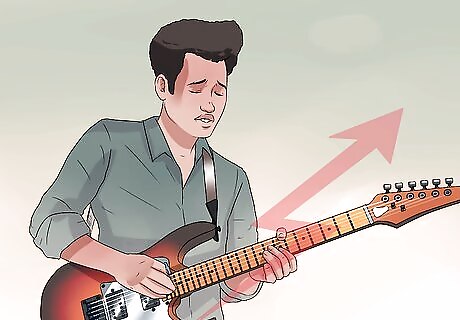
Improvise solos in your favorite scales. Not all practice has to be rote. Once you've worked through the technical exercises, bring it all together by improvising a few solos with your scales. You can search for practice tracks online by typing "Key + Your Scale + Instrumental Track," Such as "A Minor Dorian Scale Instrumental." You can also train your ear by putting on your favorite songs, then finding the key and scale by yourself. Ultimately, all the scale practice in the world means nothing if you can't use them in a song, so have some fun and start jamming. Though jams are more free-form, you should still be focusing on technique. Challenge yourself, but don't sacrifice quality of play for a few faster, sloppier notes.
Learning a New Scale
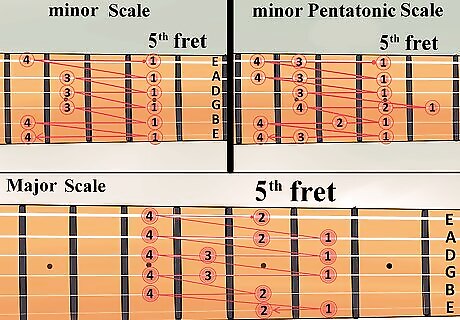
Learn the major scale, minor scale, and pentatonic scale when you first start playing. These three scales are, far and away, the most useful scales you can learn, and they are the easiest. Almost every other scale is some variation on these three scales, and the pentatonic scale -- the most common rock and blues guitar scale -- is itself just a variation on the minor scale. The following diagrams in the key of A, and are written in guitar tab. This means that the number represents the fret you need to play, and the line represents each string. Minor Pentatonic Scale: If you're playing modern music, the pentatonic scale will almost always suffice. If you want to start soloing quickly, this is the one to get down. e|---------------------5-8-------------||B|-----------------5-8-----------------G|-------------5-7---------------------|D|---------5-7-------------------------|A|-----5-7-----------------------------|E|-5-8---------------------------------| Major Scale: This is the basis of all major chords. It is bright and happy, and absolutely essential to know for music theory, but it is usually adapted when used in solos or leads: e|---------------------------4-5-|B|-----------------------5-7-----| G|-----------------4-6-7---------|D|-----------4-6-7---------------|A|-----4-5-7---------------------| E|-5-7---------------------------| Minor Scale: The basis for all minor chords, it has a darker, sadder feel. Like the major scale, most players adapt it for solos, but it is still essential for a guitarist to know: e|-----------------------------5-7-8-|B|-----------------------5-6-8-------|G|-----------------4-5-7-------------|D|-------------5-7-------------------|A|-------5-7-8-----------------------|E|-5-7-8-----------------------------
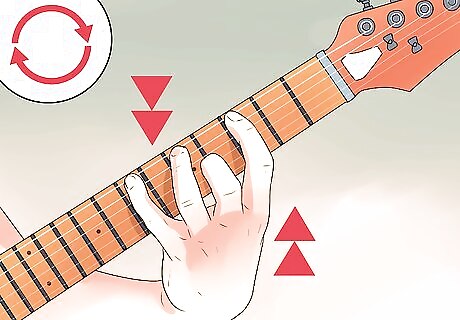
Memorize the scale by playing it up and down slowly. Start off with the basic pentatonic scale. Play each one at the pace where you can play all the notes without mistakes, and slowly speed up the pace once you get better. Always play the scale backward after playing it forwards. Don't try and create any variations now, just get used to playing all the notes, in order, front to back. You want to play slowly enough that you don't make mistakes. You don't want to reinforce bad habits when you first start learning.
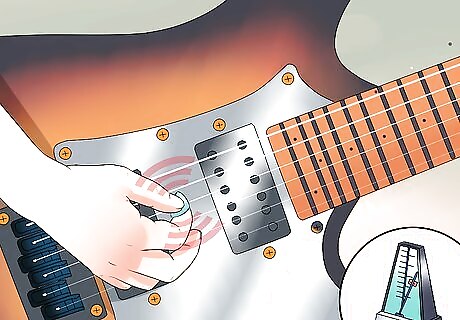
Slowly pick up speed by practicing with a metronome. To really crush your scales, you need to be able to play them to a beat. A simple metronome is a great way to keep you on time and to measure your progress. Do not, however, speed the machine up until you can comfortably play the scale up and down without mistakes. You can get free metronome apps on your phone, or find them online. Remember -- practicing scales is about technique. It may feel boring now, but you'll notice the benefits once you start using the scales for solos and licks.

Learn the scale across the guitar, not just in one place. Almost all the scales that you learn are actually "scale forms." This means that, without any extra movement, you can move them up and down the neck to put the scale in a new key. For example, the most common pentatonic scale to learn is A-Minor, where you start on the third fret. But, if the song is in E-Minor, all you have to do is make the first note an E, then play the same basic structure. Learning the notes of the guitar is essential to becoming a great soloist. Play the scales across the neck, not just in the same place.
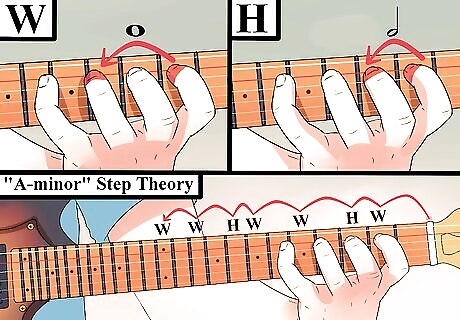
Expand your scales across the neck once you have the basics memorized. Whenever you watch great guitarists, you'll notice that they rarely stay in the same place on the guitar the entire time they solo. They move up and down, and while it seems to be at random, they know exactly where to go. This is because they understand the "intervals," which are the distances between two notes. While one could delve into interval theory for months, one basic pattern will help you expand your scale on every string across the whole neck: Step Theory: Starting on your root note (the A in an A-Minor), you could play the whole scale on one string. Simply remember W-H-W-W-H-W-W. This is the distance between notes: W stands for whole-step (2 frets) and H stands for half-step (1 fret). Try playing the whole minor scale on one string like this. Every note you play on this string could be used in a solo. As you get better, test out new notes to the left and right of your scale. Can you play a whole "solo" without touching your normal scale?
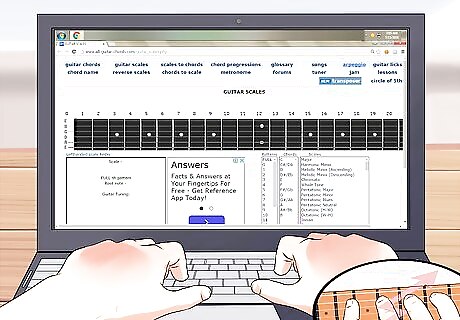
Look up new scales once you have the basics down. Scales can be found on websites such as All Guitar Chords, or Guitar Scales. You should remember, however, that it is better to master 2-3 scales then to know 30 scales in pieces. Before moving on, make sure you can play the three basics scales outlined above across the entire guitar. It not only helps you play over almost anything, it will make learning new scales easier. Modes are variations, adding and subtracting notes, on the major and minor scale. They follow a series of rules that makes them coherent and pleasing to the ear. To learn how to figure our modes by yourself, check out Wikihow's Learn Guitar Scales.

















Comments
0 comment